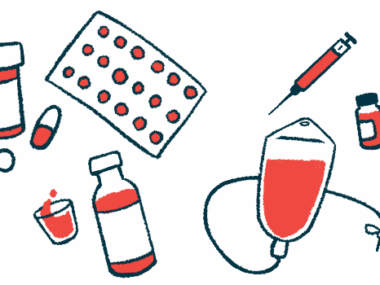Exciting Revelations from the NACFC 2018 Poster Sessions, Part 1
Written by |

The 2018 North American Cystic Fibrosis Conference site in Denver. (Photo by Tré LaRosa)
First in a series.
The poster sessions at the North American Cystic Fibrosis Conference (NACFC) in Denver this month included many interesting branches of the wonderful world of CF research. In this column, I’ll share a short overview of an interesting poster from each topic to showcase promising developments.
This is not intended to be comprehensive, as reading over 800 abstracts isn’t feasible. I also don’t pretend to be an expert on all of these topics, so I will briefly discuss the abstracts and why I think they’re relevant. You can view a PDF of the abstracts here.
CFTR
“Correction of CFTR Mutations Using Peptide Nucleic Acids Delivered in Polymeric Nanoparticles in Vitro“
- These scientists show that they can use “peptide nucleic acids delivered in polymeric nanoparticles” to functionally and genetically correct the CFTR mutation ∆F508. Probably more interestingly, they also were able to correct the mutation W1282X, which currently has no therapeutic treatment.
- Gene editing is a sexy topic right now. The fact that these scientists were able to utilize these peptide nucleic acids as nanoparticles to correct ∆F508 is impressive stuff. But it’s clearly more impressive that they were able to correct the stop mutation W1282X.
Airway physiology, pathophysiology, and defense
“A Novel Pseudomonas Virulence Factor Responsible for Dysregulated CFTR Trafficking“
- “Pseudomonas aeruginosa (Pa) is a gram-negative pathogen responsible for a variety of opportunistic infections” and “has been shown to reduce mucociliary clearance in airway epithelial cells by altering the trafficking of CFTR,” the poster notes.
- Because Pa is so destructive in CF lungs, it’s clinically relevant. The fact that it downregulates CFTR function is unexpected. I hope this is studied in terms of its relevance to modulator therapy.
Genetics
“Dysregulation of Circadian Rhythm Gene Expression in CF Mice”
- This one is pretty simple. Researchers showed that CF mice had dysregulated circadian rhythm, which they believe could possibly explain sleep disturbances in people with CF.
Model systems
“Robust Protocol for Gene Editing Human Pluripotent Stem Cells”
- Human pluripotent stem cells (hPSCs) offer the opportunity to model “all affected tissues in multi-organ diseases,” which would be a powerful model for CF. Researchers developed a “robust protocol for gene editing hPSCs that should facilitate the production of new ‘in-house’ CF and corrected hPSC lines, expanding the range of tissue-specific models for CF research, and improve CF personalized medicine.”
- This is so cool to me. If scientists have the ability to genetically edit human pluripotent stem cells, well, that’s incredibly powerful and potentially offers the ability to investigate all sorts of different organ dysfunction in models. Hopefully, this can help develop better therapies.
New therapies, biomarkers, and outcome measures
“In Utero Gene Editing as a Treatment for Cystic Fibrosis”
- Because many neonates and infants with CF already have pronounced disease, these researchers wanted to find out if they could safely administer biodegradable nanoparticles loaded with peptic nucleic acids and donor DNA to mice to correct the F508del mutation in utero, resulting in “sustained postnatal CFTR function.”
- Their findings “represent the first systemic in utero correction of a CFTR mutation and establish the feasibility of a fetal gene editing approach that could be used in the treatment of numerous CF disease-causing mutations,” the study says.
- More gene editing! Similar to what I wrote about what a cure means a couple of weeks ago, it’s important that the strategies we develop are accessible as early as possible. If we can successfully edit CFTR dysfunction in utero, we might eliminate many problems CF neonates and infants face.
Infection
“Home Drinking Water Is a Source of Clinically Relevant CF Bacterial Pathogens“
- CF pathogens are a huge part of our lives, and we will all be affected by one or another, or multiple ones. Their sources are certainly relevant.
- “The source of bacteria causing airway infections in people with CF is often thought to be the environment, although it is unclear which specific environmental exposures pose the greatest risk of infection,” the study notes.
- After finding many common CF pathogens in the home drinking water of people with CF, researchers concluded that might be where people with CF come in contact with bacteria. It’s unclear if home drinking water the only reason for this. They also developed tools for screening CF pathogens in environmental samples, which they believe have “far-reaching applications for the identification of other sources of clinically relevant pathogens that pose a risk to people with CF.”
- Considering all the environmental issues we need be cautious of, I would have never thought about this. It’s something to consider, but until we have a way to clean the water of these pathogens, I’m not sure it will change anything. Their tools might, though.
In conclusion, a lot of extremely exciting stuff is happening in the CF community! Check back next week for more interesting discoveries.
***
Note: Cystic Fibrosis News Today is strictly a news and information website about the disease. It does not provide medical advice, diagnosis, or treatment. This content is not intended to be a substitute for professional medical advice, diagnosis, or treatment. Always seek the advice of your physician or other qualified health provider with any questions you may have regarding a medical condition. Never disregard professional medical advice or delay in seeking it because of something you have read on this website. The opinions expressed in this column are not those of Cystic Fibrosis News Today, or its parent company, Bionews Services, and are intended to spark discussion about issues pertaining to cystic fibrosis.







Leave a comment
Fill in the required fields to post. Your email address will not be published.